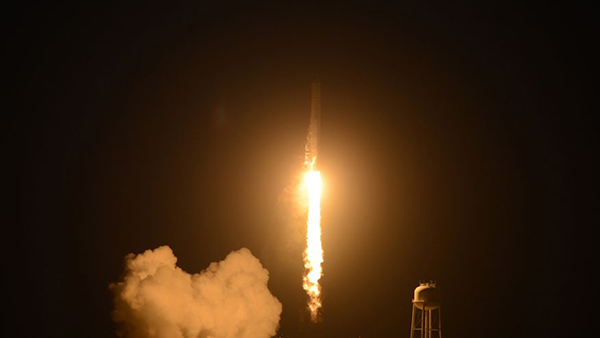 The explosion of a commercial Antares rocket just seconds after lifting off from Virginia’s Eastern Shore Tuesday night has touched off an in-depth investigation into the launch failure by NASA and the rocket’s builder, the Orbital Sciences Corporation.
The explosion of a commercial Antares rocket just seconds after lifting off from Virginia’s Eastern Shore Tuesday night has touched off an in-depth investigation into the launch failure by NASA and the rocket’s builder, the Orbital Sciences Corporation.
The Antares rocket exploded in a massive fireball just after its 6:22 p.m. EDT launch on Tuesday evening (Oct. 28) from NASA’s Wallops Flight Facility on Wallops Island, Virginia. The rocket was carrying an unmanned Cygnus spacecraft — also built by Orbital — that was packed with about 2.5 tons of supplies for astronauts on the International Space Station.
Orbital Sciences, based in Dulles, Virginia, will lead the investigation into the Antares rocket launch failure, with the Federal Aviation Administration and NASA supporting the company’s analysis. No one was injured during the rocket explosion, according to NASA and Orbital, and it is too early to tell what caused the failure.
“As far as the next steps for Antares, we will not fly until we understand the root cause and the corrective action necessary to ensure this doesn’t happen again,” Orbital Sciences executive vice president Frank Culbertson said during a news conference after the rocket failure. “It’s way too early to tell how long that might take. We will go through the proper processes. We will do it professionally and thoroughly … But I can assure you that we will find out what went wrong. We will correct it, and we will fly again.”
The Cygnus spacecraft was carrying about 5,000 lbs. of food, science supplies and other items when the rocket failure occurred. If the launch had gone off as planned, it would have kicked off Orbital Sciences’ third resupply mission to the space station under a $1.9 billion contract for eight flights to the orbiting outpost for NASA.
Another company, the California-based firm SpaceX, has a separate contract for $1.6 billion to fly 12 robotic cargo delivery missions using its own Dragon spacecraft and Falcon 9 rockets. SpaceX has flown four of those missions so far.
Orbital Sciences representatives do not yet know if the failure is related to the failed test of an AJ26 rocket engine (the type of rocket engines used in the Antares first stage) last May.
While Tuesday’s launch failure is disappointing, the crewmembers on the space station have more than enough supplies onboard the orbiting outpost, according to Mike Suffredini, the head of NASA’s International Space Station program office.
“We did inform the crew immediately after it [the launch failure] occurred,” Suffredini said during the news conference. “We actually had the feed up to them, so they were witness to it. They were disappointed … Of course, they are well aware that they have plenty of resources on orbit to get along for some time and the vehicles that are getting up there in the near-term.”
Russian officials are planning to launch an unmanned Progress cargo ship to the space station from Russia in the wee hours of Wednesday morning (Oct. 29), and SpaceX’s fifth cargo mission is scheduled to launch in early December.
Two members of Congress also expressed their feelings about the failed launch.
“We add our disappointment to the thousands in the space community who worked tirelessly in support of Tuesday evening’s launch attempt at Wallops Island,” Lamar Smith (R-Texas) and Steven Palazzo (R-Miss.) said in a joint statement. “We are relieved to hear there are no reported fatalities, and we anticipate learning more about the circumstances surrounding the launch failure in the near future.”
Smith is the chairman of the House Science, Space, and Technology Committee, while Palazzo serves as the chair on the committee’s Space subcommittee.
